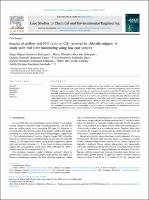| dc.contributor.author | Gutierrez Rodriguez, Diego Miguel | |
| dc.contributor.author | Alvarado Orbegoso, María Albertina | |
| dc.contributor.author | Quiñones Cerna, Claudio Eduardo | |
| dc.contributor.author | Azabache Liza, Yrwin Francisco | |
| dc.contributor.author | Rodriguez Espinoza, Ronald Fernando | |
| dc.contributor.author | Robles Castillo, Heber Max | |
| dc.contributor.author | Guerrero Escobedo, Adolfo Enrique | |
| dc.date.accessioned | 2025-07-01T20:38:39Z | |
| dc.date.available | 2025-07-01T20:38:39Z | |
| dc.date.issued | 2025-05-19 | |
| dc.identifier.uri | https://hdl.handle.net/20.500.13067/3858 | |
| dc.description.abstract | Climate change represents one of the greatest challenges we face globally, and reducing carbon dioxide (CO2)
emissions is among the most urgent actions. In this study, we explored an alternative approach using microalgae
(Chlorella vulgaris) to capture CO2 from the air, employing an Arduino-controlled biofiltration system with
accessible sensors such as the MQ-135 and TESTO 535. We tested different airflow rates (50, 75, and 100 L per
hour) and nutrient combinations (N/P ratios of 0, 108.33, and 216.67) to identify the most efficient conditions.
Unlike other studies, we integrated real-time monitoring of variables such as CO2 concentration, temperature,
and light within a modular, easily adaptable system. The best results were achieved with a flow rate of 100 L/h
and an N/P ratio of 216.67, yielding a capture efficiency of 34.88 % and a daily productivity of nearly to 1 g/L.
This proposal demonstrates that it is possible to develop effective, economical, and replicable solutions that
combine accessible technology and biotechnology to help mitigate climate change. | es_PE |
| dc.format | application/pdf | es_PE |
| dc.language.iso | eng | es_PE |
| dc.publisher | Elsevier | es_PE |
| dc.rights | info:eu-repo/semantics/openAccess | es_PE |
| dc.rights.uri | https://creativecommons.org/licenses/by-nc-nd/4.0/ | es_PE |
| dc.subject | Biotechnology | es_PE |
| dc.subject | Microalgae | es_PE |
| dc.subject | Biofixation | es_PE |
| dc.subject | Biofilter | es_PE |
| dc.subject | Mitigation | es_PE |
| dc.title | Impact of airflow and N/P ratio on CO2 removal by chlorella vulgaris: A study with real-time monitoring using low-cost sensors | es_PE |
| dc.type | info:eu-repo/semantics/article | es_PE |
| dc.identifier.journal | Case Studies in Chemical and Environmental Engineering | es_PE |
| dc.identifier.doi | https://doi.org/10.1016/j.cscee.2025.101239 | |
| dc.subject.ocde | https://purl.org/pe-repo/ocde/ford#2.07.00 | es_PE |
| dc.publisher.country | PE | es_PE |
| dc.source.volume | 12 | es_PE |
| dc.source.beginpage | 1 | es_PE |
| dc.source.endpage | 17 | es_PE |


